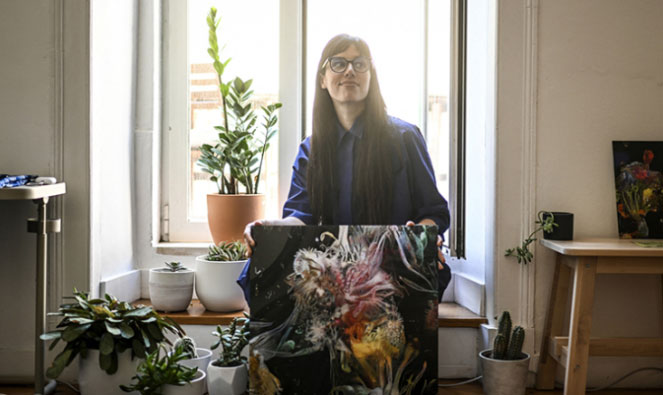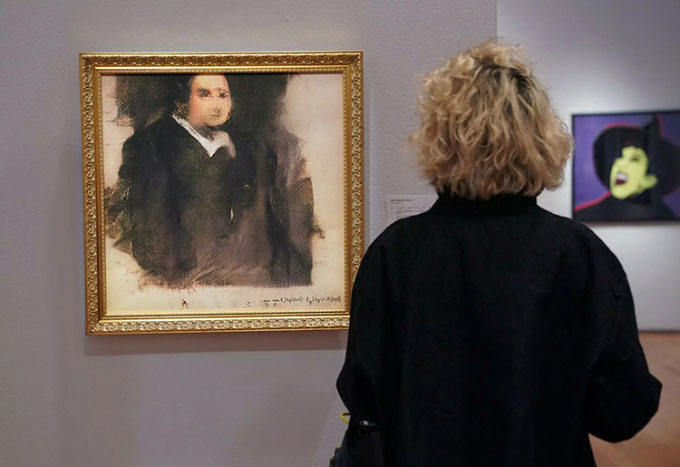Artificial Intelligence (AI) promises to be the next breakthrough in art, but human creativity remains central.
Argentinian artist Sofia Crespo is one of the pioneers of the “AI-generated art” movement, where humans set rules for computers, which then use algorithms to create drawings, ideas, and new patterns.

Sofia Crespo photographed with one of her “AI works” on June 8, 2022. (Photo: AFP)
This field has begun to attract significant interest from art collectors and has even been highly valued at auctions.
In March of this year, 22-year-old American artist and programmer Robbie Barrat sold a piece titled “Nude Portrait#7Frame#64″—created with AI assistance—for £630,000, equivalent to $821,000, at Sotheby’s auction house.
Nearly four years earlier, at an auction held by Christie’s, the French collective Obvious—composed of artists working with artificial intelligence—also sold a work titled “Edmond de Belamy” for $432,500.

The AI artwork “Edmond de Belamy” fetched $432,500 at auction four years ago. (Photo: AFP)
These initial transactions are laying the groundwork for a major turning point, as more and more tech companies begin to release AI tools capable of creating realistic images in just seconds.
Collector Jason Bailey told AFP that AI-generated art is “like a ballet between humans and machines.”
Since the 1960s, artists in Germany and the United States have left their mark with computer art. The V&A Museum in London still preserves a collection dating back over half a century, including a standout piece from 1968 titled “Plastik 1” by German artist Georg Nees.
Nees used random number generation (RNG) on computers to create geometric designs for his sculptures.
Today, digital artists work with supercomputers and generative adversarial networks (GANs) to create images that are far more complex than anything Nees could have imagined.
GANs consist of competing AIs, where one AI generates images based on the instructions given, and another AI acts as a “gatekeeper,” assessing whether the output is accurate. If it detects an error, it sends the image back for revision, and the first AI works on it again for a moment, trying to outsmart the competing AI.

Crespo believes AI-equipped machines cannot replace humans in art. (Photo: AFP)
Nevertheless, artists like Crespo and Barrat emphasize that humans remain at the center of the process, even if their methods are not traditional.
“When I work this way, I am not creating images. I am creating a system that can generate images,” Barrat explains.
Crespo once thought that her AI machine was a true “collaborator,” but in reality, it is very difficult to achieve “even a single line of code” that produces the desired results.
Today, major tech companies like Google and OpenAI are promoting the value of new tools that they claim will bring realism and creativity without the need for coding skills.
They have replaced GANs with more user-friendly AI models known as “transformers,” capable of converting everyday language into images.
Google Images is filled with creative images generated by prompts such as: “A small cactus wearing a straw hat and sunglasses in the Sahara Desert.”
OpenAI proudly states that their DALL-E 2 tool can generate any scenario in any artistic style, from ancient Flemish masters to contemporary artist Andy Warhol.
While the rise of AI has led many to be replaced by machines in various fields like customer service, artists view the AI boom as an opportunity rather than a threat.
Crespo has tried DALL-E 2 and praised it as a “new level of image generation in general,” although she still prefers her GAN.
“I often don’t need a model that is too precise to create my work, as I really enjoy when everything looks uncertain and unrecognizable,” Crespo shares.
Artist Camille Lenglois from the Pompidou Center in Paris—the largest contemporary art collection in Europe—also dismisses any notions that artists are about to be replaced by machines. She emphasizes that machines do not yet possess “the ability to create and critique,” and asserts that “the ability to create realistic images does not make someone an artist.”


















































